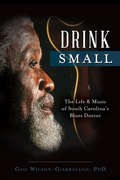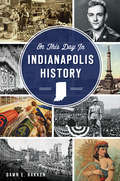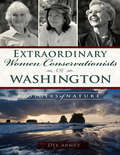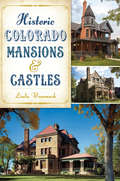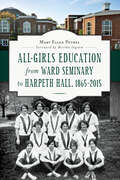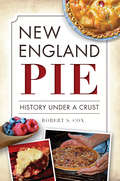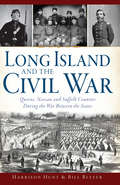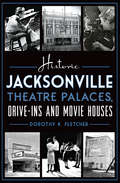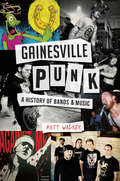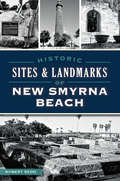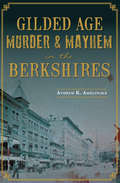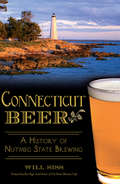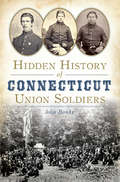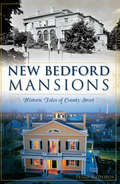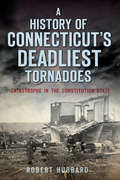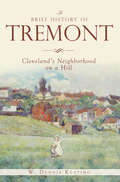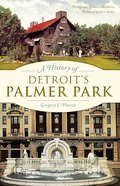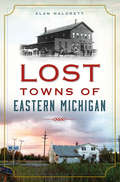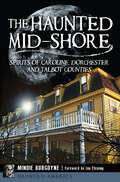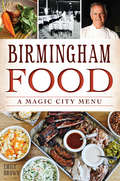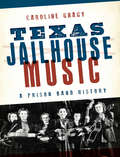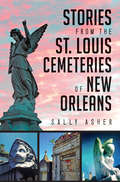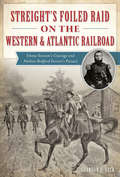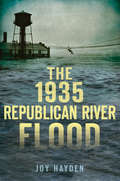- Table View
- List View
Drink Small: The Life & Music of South Carolina's Blues Doctor (Music Ser.)
by Gail Wilson-GiarratanoFor fans of the blues, Drink Small is synonymous with South Carolina. Drink rose from the cotton fields of Bishopville to become a music legend in the Palmetto State and beyond. The self-taught guitarist has written hundreds of songs and recorded dozens of albums spanning the genres of country, blues, folk, gospel and shag. The success of that music allowed him countless honors, such as playing the stages of the Apollo and Howard Theaters, touring with legendary R&B singer Sam Cooke and playing the best blues festivals in the world. He even developed his own philosophy: Drinkism. Author Gail Wilson-Giarratano details the dream, the music and the life that created the Blues Doctor.
On This Day in Indianapolis History
by Dawn E. BakkenAlthough best known for "The Greatest Spectacle in Racing," Indianapolis claims countless fascinating stories that happened off the track--one for every date on the calendar. In a single day on January 1, 1970, Indianapolis jumped from the nation's twenty-sixth largest city to number eleven. On July 25, 1934, gangster and native son John Dillinger was laid to rest in Crown Hill Cemetery, where chips of his four successive gravestones became favorite city souvenirs. On September 17, 1945, the nation finally learned that Indianapolis was the top-secret manufacturing center for the Norden bombsight, crucial to Allied victory. And on September 6, 1959, jazz musician Wes Montgomery and his brothers finished recording one of their most popular albums. One day at a time, author Dawn Bakken chronicles a year of people, places and events in Circle City history.
Extraordinary Women Conservationists of Washington: Mothers of Nature
by Dee ArntzCourageous women are to thank for many of Washington's environmental conservation successes. Bonnie Phillips, Melanie Rowland and Helen Engle battled harmful timber cutting. Polly Dyer and Emily Haig worked to expand Olympic National Park and organized efforts to establish North Cascades National Park. Women helped create the Washington Environmental Council and Washington Conservation Voters. As a state representative, Jolene Unsoeld led the fight against Boeing and other major corporations to pass the state Model Toxics Control Act. Author and Washington conservationist Dee Arntz recounts these important stories and many others, showing that the legacy of Washington's female conservationists is nothing short of extraordinary.
Historic Colorado Mansions & Castles (Landmarks)
by Linda WommackThe discovery of gold and silver in Colorado's Rocky Mountains minted millionaires by the ton. The rough settlements of miners and ranchers quickly transformed into habitations more suitable for the newly wealthy class. William Newton Byers founded the Centennial State's first newspaper and built an Italianate-style palace with the proceeds, while Walter Scott Cheesman's Capitol Hill home later became the governor's residence. Stroll into the parlors and drawing rooms of oligarchs like August A. Meyer, Lyman Robison and James Joseph Brown. Visit Romanesque castles cut from native lava and country retreats designed by the country's foremost architects. Linda Wommack offers a tour of the finest mansions in Colorado, all proudly bearing the mark of the State and National Registers of Historic Preservation.
All-Girls Education from Ward Seminary to Harpeth Hall: 1865-2015
by Martha Ingram Mary Ellen PethelDuring the final days of the Civil War, Dr. William Ward and his wife, Eliza Ward, envisioned a school for young women in Nashville that would evolve into one of the nation's most prestigious institutions. As the New South dawned, Ward Seminary opened its doors in September 1865. Merging with Belmont College for Young Women in 1913, Ward-Belmont operated as a college preparatory school, music conservatory, and junior college. In 1951, the high school division moved farther west, reopening as the Harpeth Hall School after Ward-Belmont's sudden closure. Ward Seminary, Belmont College, Ward-Belmont, and Harpeth Hall are simply separate chapters of one continuous story. As Harpeth Hall celebrates 150 years, its story reflects a unique case study and provides a lens through which to understand the evolution of all-girls education in the United States. The Harpeth Hall School remains one of the oldest all-girls college preparatory schools in the South.
New England Pie: History Under a Crust (American Palate Ser.)
by Robert S. CoxPie has been a delectable centerpiece of Yankee tables since Europeans first landed on New England's shores in the seventeenth century. With a satisfying variety of savory and sweet, author Robert Cox takes a bite out of the history of pie and pie-making in the region. From the crackling topmost crust to the bottom layer, explore the origin and evolution of popular ingredients like the Revolutionary roots of the Boston cream. One month at a time, celebrate the seasonal fixings that fill New Englanders' favorite dessert from apple and cherry to pumpkin and squash. With interviews from local bakers, classic recipes and some modern twists on beloved standards, this mouthwatering history of New England pies offers something for every appetite.
Long Island and the Civil War: Queens, Nassau and Suffolk Counties During the War Between the States (Civil War Series)
by Harrison Hunt Bill BleyerAlthough no battles were fought on Long Island, the Civil War deeply affected all of its residents. More than three thousand men--white and black--from current-day Queens, Nassau and Suffolk Counties answered the call to preserve the Union. While Confederate ships lurked within eight miles of Montauk Point, camps in Mineola and Willets Point trained regiments. Local women raised thousands of dollars for Union hospitals, and Long Island companies manufactured uniforms, drums and medicines for the army. At the same time, a little-remembered draft riot occurred in Jamaica in 1863. Local authors Harrison Hunt and Bill Bleyer explore this fascinating story, from the 1860 presidential campaign that polarized the region to the wartime experiences of Long Islanders on the battlefield and at home.
Historic Jacksonville Theatre Palaces, Drive-ins and Movie Houses (Landmarks)
by Dorothy K. FletcherJacksonville's theatre and performance history is rich with flair and drama. The theatres, drive-ins and movie houses that brought entertainment to its citizens have their own exciting stories. Some have passed into memory. The Dixie Theatre, originally part of Dixieland Park, began to fade in 1909. The Palace Theatre, home to vaudeville acts, was torn down in the '50s. The Alhambra has been everyone's favorite dinner theatre since 1967's debut of Come Blow Your Horn. Local author Dorothy K. Fletcher revives the history of Jacksonville's theatres. Lights, camera, action!
Gainesville Punk: A History of Bands & Music
by Matt WalkerKnown for The Fest, Less Than Jake and Hot Water Music, Gainesville became a creative hub in the 1980s and '90s for many of punk rock's greats. Whether playing at the Hardback or wild house parties, earnest acts like Against Me!, Spoke and Roach Motel all emerged and thrived in the small northern Florida city. Radon burst onto the scene with chaotic energy while Mutley Chix helped inspire local torchbearers No Idea Records. Through this succinct history, author Matt Walker traces each successive generation's contributions and amplifies the fidelity of the Gainesville scene.
Historic Sites & Landmarks of New Smyrna Beach (Landmarks)
by Robert ReddNew Smyrna Beach is the third-oldest city in Florida behind only St. Augustine and Pensacola. Originally settled by Dr. Andrew Turnbull in 1768, the city accumulated significant, intriguing and stunning monuments to its past. An unusual-looking memorial to world war heroes--a cross, battle helmet and eagle--sits at Riverside Park. One of the oddest sites is a single-stone cemetery with a vault dedicated to the memory of Charles Dummett. Because of the insects that inhabit Ponce Inlet, a well-known landmark was originally named Mosquito Inlet Lighthouse. Local author and historian Robert Redd guides readers through the iconic historical landmarks of "Florida's Secret Pearl."
Jacksonville Food Trucks: Stories & Recipes from the Road (American Palate)
by Nancy WhiteFood trucks in Jacksonville are a smashing success. The early popularity of trucks like Corner Taco and On the Fly set the stage for a mobile dining revolution. Innovators such as Mike Field and Jax Truckies supplied the vision and passionately advocated for the cause. From Beer Cheese Soup to Chicken Madras, the astounding variety of menus, themes and trucks means there's something for all locals to enjoy. Author and "Nourish the Beast" blogger Nancy White includes fascinating stories and mouth-watering recipes as she chronicles the rise of food trucks on Florida's First Coast.
Gilded Age Murder & Mayhem in the Berkshires (Murder And Mayhem Ser.)
by Andrew K. AmelinckxThis criminal history of the Berkshires is brimming with unforgettable stories of greed, jealousy, and madness from the turn of the twentieth century. The Berkshires of Western Massachusetts are known for their picturesque beauty, but this history offers a fascinating look at the region&’s dark side. This chronicle includes true tales of greed, betrayal and violence in The Bay State. In the summer of 1893, a tall and well-dressed burglar plundered the massive summer mansions of the upper crust . . . A visit from President Teddy Roosevelt in 1902 ended in tragedy when a trolley car smashed into the presidential carriage, killing a Secret Service agent . . . A psychotic millworker opened fire on a packed streetcar, leaving three dead and five wounded, shocking the nation . . . These and many more stories—from axe murders to botched bank jobs—paint a stark portrait of the inequities that shadowed the extravagance of the Gilded Age.
Connecticut Beer: A History of Nutmeg State Brewing (American Palate)
by Will Siss Ron PageThe history of the frothy beverage in Connecticut dates back to early colonists, who used it to quench their thirst in the absence of clean drinking water. So integral was beer to daily life in the colony that government officials and militiamen congregated in taverns like the General Wolfe to talk laws and business over pints of ale. Over the next two centuries, the number of breweries rose and then declined, especially after Prohibition. It was not until the 1980s that homebrewers brought this vital Nutmeg State tradition back to life, hatching the likes of New England and Cottrell Brewing Companies, as well as brewpubs including City Steam and Southport Brewing. More recently, small operations with one or two people, such as Relic and Beer'd, are changing the landscape again. Connecticut beer writer Will Siss introduces readers to the hardworking people who keep the breweries and beer bars inviting and the hoppy history alive.
Hidden History of Connecticut Union Soldiers (Hidden History)
by John BanksOver fifty thousand Connecticut soldiers served in the Union army during the Civil War, yet their stories are nearly forgotten today. Among the regiments that served, at least forty sets of brothers perished from battlefield wounds or disease. Little known is the 16th Connecticut chaplain who, as prisoner of war, boldly disregarded a Rebel commander's order forbidding him to pray aloud for President Lincoln. Then there is the story of the 7th Connecticut private who murdered a fellow soldier in the heat of battle and believed the man's ghost returned to torment him. Seven soldiers from Connecticut tragically drowned two weeks after the war officially ended when their ship collided with another vessel on the Potomac. Join author John Banks as he shines a light on many of these forgotten Connecticut Yankees.
New Bedford Mansions: Historic Tales of County Street (Landmarks)
by Peggi MedeirosThe early nineteenth century in New Bedford was a time of unimaginable wealth, intellectual ferment and artistic treasures. Prosperous whaling magnates like members of the Rotch, Morgan and Howland families commissioned the nation's finest architects to design and construct their majestic mansions. The city's architectural and cultural expansion brought great writers and artists like Henry David Thoreau and Ralph Waldo Emerson into the homes of County Street's elite. Yet behind the elegant façade of grand parties and notable house guests were the secrets and scandals of New Bedford's upper crust. Join author Peggi Medeiros as she chronicles the history of each mansion and the stories once hidden behind closed doors.
A History of Connecticut's Deadliest Tornadoes: Catastrophe in the Constitution State (Disaster)
by Robert HubbardThe Wallingford tornado of 1878 took less than two minutes, but it killed at the rate of one person per second. Twisters in Connecticut are incredibly rare, but they're often disastrous and sometimes deadly. The Windsor tornado of 1979 destroyed a field of aircraft that had survived World War II. The 1787 Wethersfield tornado ripped off a barn roof in New Britain, traveled on to Newington and finally subsided in Wethersfield after destroying a family farm. Locals remember the 1989 cyclone that ripped through Hamden and cost the state millions of dollars in repairs. Join local author Robert Hubbard as he shares the tales of these natural disasters and those who witnessed them.
A Brief History of Tremont: Cleveland’s Neighborhood on a Hill (Brief History)
by W. Dennis KeatingFor almost two centuries, the historic Tremont neighborhood has rested on a bluff overlooking Cleveland's industrial valley. The sleepy farming community was transformed in 1867, when Cleveland annexed it. Factories attracted thousands of emigrants from Europe, and industrialization gave rise to a class of wealthy businessmen. After the city prospered as a manufacturing center during World War II, deindustrialization and suburbanization fueled a huge population loss, and the neighborhood declined as highways cut through. The 1980s marked the beginning of the rebirth of the cultural treasure Tremont became. Author W. Dennis Keating chronicles the challenges and triumphs of this diverse and vibrant community.
A History of Detroit's Palmer Park (Landmarks)
by Gregory C. PiazzaPalmer Park is Detroit's underappreciated architectural jewel. Located around the intersection of McNichols Road (Six Mile) and Woodward Avenue, it embraces every style of the late nineteenth and early twentieth centuries. United States senator Thomas Palmer originally developed the property as farmland and donated it to the city in the 1890s. Between 1924 and 1964, its character changed with some of the best examples of modern apartment living from top local architects, including one of just five buildings credited to the world-renowned Albert Kahn. Author Gregory C. Piazza showcases the exceptional story of building Palmer Park.
Lost Towns of Eastern Michigan (Lost)
by Alan NaldrettMany of eastern Michigan's old boomtowns and sleepy villages are faded memories. Nature reclaimed the ruins of some while progress paved over the rest. Discover the stories of lost communities hidden in plain sight or just off the beaten track. The vanished religious colony of Ora Labora fell into a state of near-constant inebriation when beer became the only safe liquid to drink. Lake St. Clair swallowed up the unique currency of Belividere along with the place that issued it. Abandoned towns still crumble within Detroit's city limits. Alan Naldrett delves into the fascinating history of eastern Michigan's lost settlements.
Haunted Mid-Shore, The: Spirits of Caroline, Dorchester and Talbot Counties (Haunted America)
by Ian Fleming Mindie BurgoyneThere is an otherworldly quality to the Mid-Shore--ghosts seem to rise up from the Chesapeake, and quaint towns hold the spirits of their historic pasts. Oxford's Robert Morris Inn is still home to its colonial namesake, while the Kemp House in St. Michael's is host to the restless specter of Robert E. Lee. Murdered actress Marguerite rides the elevator of the Avalon Theater, and Wish Sheppard stalks the halls of the Denton Jail. Near the witching hour, the eerie sound of the swinging body of "Bloody" Henny Insley can be heard on the grounds of the Dorchester Courthouse. Author and ghost tour guide Mindie Burgoyne takes a chilling journey into the supernatural lore of Maryland's Mid-Shore.
Birmingham Food: A Magic City Menu (American Palate)
by Emily BrownBirmingham began as a boomtown filled with immigrants who held on to the best recipes from their homelands. More recently, locals like Frank Stitt and Carole Griffin helped transform the modern southern city into a foodie destination with the best of national trends. Andrew Zimmern visited with his show Bizarre Foods America to tout one of the city's most popular food trucks, Shindigs. Fast casual dining is done with care, and gems like Trattoria Centrale and Bettola are dedicated to local ingredients. Join food writer and restaurant enthusiast Emily Brown as she details the delectable history of food in the Magic City.
Texas Jailhouse Music: A Prison Band History
by Caroline GnagyInside the Texas State Prison is a surprising story of ingenuity, optimism and musical creativity. During the mid-twentieth century, inmates at the Huntsville unit and neighboring Goree State Farm for Women captured hearts all over Texas during weekly radio broadcasts and live stage performances. WBAP's Thirty Minutes Behind the Walls took listeners inside the penitentiary to hear not only the prisoners? songs but also the stories of those who sang them. Captivating and charismatic, banjo player Reable Childs received thousands of fan letters with the Goree All-Girl String Band during World War II. Hattie Ellis, a young black inmate with a voice that rivaled Billie Holiday's, was immortalized by notable folklorist John Avery Lomax. Cowboys, songsters and champion fiddlers all played a part in one of the most unique prison histories in the nation. Caroline Gnagy presents the decades-long story of the Texas convict bands, informed by prison records, radio show transcripts and the words and music of the inmates themselves.
Stories from the St. Louis Cemeteries of New Orleans (Landmarks)
by Sally AsherThe tombs and graves of the St. Louis Cemeteries rise from the ground, creating labyrinthine memorials aptly dubbed "cities of the dead." Most are in even rows with quaint street names. Some are of crumbling brick and broken marble. Others are miniature mansions clad in decorative ironwork with angelic guardians. Grand or humble, each is a relic of the story of New Orleans. Politicians, pirates, Mardi Gras Indian chiefs and one voodoo queen rest below. In an unprecedented inquiry, author Sally Asher reveals the lives within the mysterious and majestic tombs of the St. Louis Cemeteries.
Streight's Foiled Raid on the Western & Atlantic Railroad: Emma Sansom’s Courage and Nathan Bedford Forrest’s Pursuit (Civil War Series)
by Brandon H. BeckIn the spring of 1863, Union colonel Abel D. Streight sought to raid and destroy parts of the vital span of the Western and Atlantic Railroad in north Georgia with his mule-riding infantry brigade. Determined to thwart the potentially deadly attack, Confederate general Nathan Bedford Forrest fervently pursued Streight's forces. With the help of unlikely ally fifteen-year-old Emma Sansom of Gadson, Alabama, Forrest falsely convinced Streight he was vastly outnumbered, foiled the raid and forced Streight's surrender. Brandon H. Beck details Streight's dubious plan and the exciting story of a running battle between hunter and quarry that colors history from the hills of northeast Mississippi to the heart of Georgia.
The 1935 Republican River Flood (Disaster)
by Joy HaydenOn May 31, 1935, a storm system surged along the Republican River, bursting its banks in a matter of minutes with a roar that could be heard miles away. The greatest flood to hit the tri-state area of Colorado, Kansas and Nebraska, it left behind a landscape rearranged beyond recognition and claimed more than one hundred casualties. However, amid all the destruction and sorrow, amazing acts of heroism and unwavering courage were reported throughout the valley. Author Joy Hayden reveals the historic disaster and the steadfast resolve of those who witnessed it.
